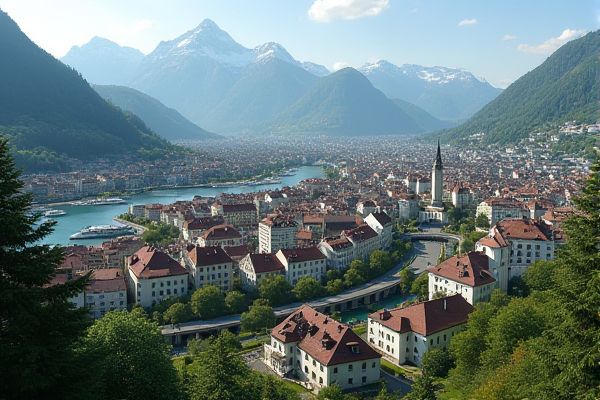
Dining and food culture in Austria: Emphasis on local, seasonal ingredients. Hearty traditional Austrian dishes. Popularity of coffee and cake culture. Tipping is customary in restaurants. Dining etiquette emphasizes politeness. Extended meal times, especially dinners. Bread and pastries are staple offerings. Importance of regional specialties by province. Craft beer and wine consumption. Diverse international dining options available.
Emphasis on local, seasonal ingredients
Austrian cuisine places a strong emphasis on local and seasonal ingredients, with regions like Salzburg, Styria, and Upper Austria highlighting farm-to-table dining, the use of fresh produce from local farms, and the incorporation of seasonal ingredients such as asparagus, wild game, and apples into their dishes. This focus on local sourcing and seasonal availability is reflected in the popularity of farmers' markets, farm shops, and the adaptation of menus based on the availability of local ingredients.
Hearty traditional Austrian dishes
Traditional Austrian cuisine is characterized by hearty dishes such as Tiroler Grostl (a mix of potatoes, onions, and meat fried with a fried egg on top), Tafelspitz (boiled beef served with horseradish and apples), Speckknodel (bacon dumplings), Kasspatzln (cheese noodles), and Schweinebraten (oven-roasted pork with bread dumplings and sauerkraut), reflecting the country's rich culinary heritage and regional variations. For more insights on these culinary delights, you can explore the Traditional Austrian Food guide.
Popularity of coffee and cake culture
In Austria, and especially in Vienna, the coffee and cake culture is an esteemed tradition, with many locals indulging in a "coffee and cake" break around 3:00 pm. This ritual is woven into the country's leisurely lifestyle, where cafes buzz with social gatherings, offering a remarkable selection of cakes and pastries. Among these delicacies, the Sachertorte stands out as a quintessential Viennese treat. Accompanying these delightful sweets are distinctive coffee beverages like the Kleiner Brauner and Wiener Melange, served amidst the elegant and welcoming atmosphere of Viennese cafes. The emphasis on social interaction and relaxation makes coffee and cake not just a dining experience, but a cultural cornerstone that reflects the unique charm of Austria.
Tipping is customary in restaurants
In Austria, tipping in restaurants is customary, with etiquette experts recommending 10% to 15% of the bill, or even up to 20% for exceptional service. It is common to round up to the next even number or specify the total amount including the tip when paying, rather than leaving cash on the table. For a comprehensive overview of this practice, you can visit the Austria Tipping Guide which provides detailed insights into the nuances of tipping etiquette in the country.
Dining etiquette emphasizes politeness
In Austria, dining etiquette emphasizes politeness, highlighting the importance of not beginning to eat until the host says "Guten Appetit" or "Mahlzeit." It involves using Continental table manners and maintaining formal interactions, such as making eye contact during toasts and ensuring you finish everything on your plate. For more insights into such cultural norms, refer to the guidelines provided by Austrian Etiquette, where these customs are detailed for those seeking a deeper understanding of their significance.
Extended meal times, especially dinners
In Austria, meal times, particularly dinners, are extended affairs that can last for several hours, typically featuring at least three courses. These leisurely meals allow for ample enjoyment and socializing, as there is no rush to leave after the last bite. Such dinners are often drawn-out events, sometimes taking at least one hour for the main courses and another hour for dessert. You can delve deeper into these delightful customs by exploring the insights provided by the Taste of Austria website. Mealtimes in Austria are renowned for being lengthy social occasions.
Bread and pastries are staple offerings
In Austria, bread and pastries are integral to the dining culture, with a focus on darker, denser breads made from rye and spelt flours, and a variety of rolls such as Semmel and Kornspitz being staples, especially for breakfast and snacks in coffee houses and homes. Pastries, including iconic items like Apple Strudel, Kipfel, and various types of cakes, are also deeply ingrained in Austrian food culture, often enjoyed at any time of day. To learn more about these delights, you can explore the options at Visiting Vienna.
Importance of regional specialties by province
Austria's dining and food culture is deeply rooted in its regional specialties, with each province offering unique culinary traditions. For example, Vorarlberg is known for strong cheeses and dishes like Spatzle and Kasdonnala, Salzburg for monastic-influenced cuisine with lots of cheese, Upper Austria for dumplings and Linzer Tart, Carinthia for fish and Karnter Kasnudeln, Lower Austria for wines and white asparagus, and Burgenland for fish, poultry, and high-quality wines, each contributing to the rich diversity of Austrian Cuisine.
Craft beer and wine consumption
Austrian dining and food culture is deeply rooted in its craft beer and wine traditions. Beer, particularly styles like Marzen and Vienna lager, symbolizes community and culture, with Austria boasting the highest density of breweries in Europe. Wine consumption is also significant, with over 238 million litres consumed annually, mostly through on-trade channels and household purchases, highlighting the importance of local wine production and the diverse micro-climates in regions like the Wachau, Lower Austria, and Burgenland.
Diverse international dining options available
Austria offers a diverse dining scene, including traditional Austrian fare like Wiener Schnitzel and Tafelspitz, as well as fine dining options such as Michelin-starred restaurants in Vienna and Salzburg. Additionally, there is a wealth of international cuisine ranging from gourmet vegetarian to vegan menus at restaurants like Tian and Glass Garden. For more detailed insights into the culinary delights of Austria, visit the Lonely Planet website, which provides comprehensive guides on what to eat and drink while exploring this gastronomic haven.
